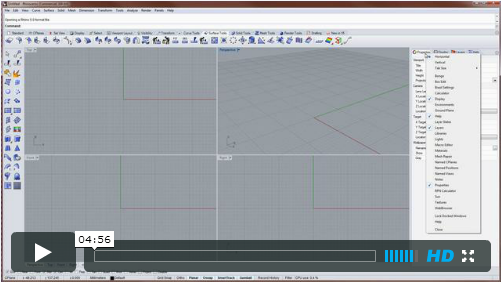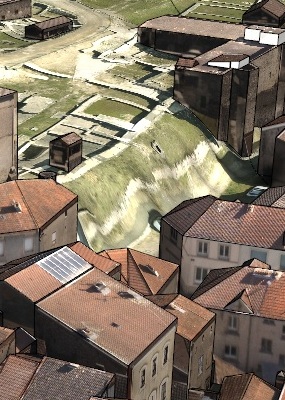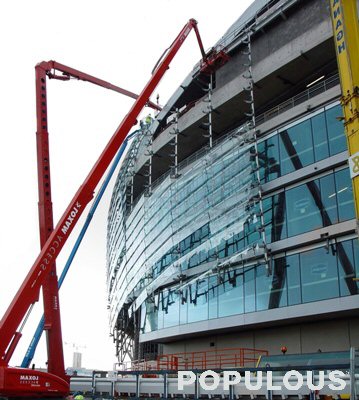 What
is new in Rhino 5
What
is new in Rhino 5
- Overview
- Modeling
- Editing
- Interface
- Display
- Rendering
- Drafting & Printing
- Digital Fab
- Mesh Tools
- 3‑D Capture
- Analysis
- Large Projects
- Compatibility
- Developer Tools
- Administration
- Beyond 5
More than 3,500 enhancements
The Rhino 5 development process started more than five years ago with one overriding goal—to remove as many of your workflow bottlenecks as possible. That meant making Rhino faster and able to handle much larger models and project teams, in addition to making thousands of large and small improvements.
Thanks to more than 40,000 pre‑release users, we were able to field test and refine Rhino 5, making it the most stable version ever.
Modeling
Object creation in Rhino continues to be enhanced. Rhino 5 adds dozens of refinements to existing tools, some new commands, and the new lightweight extrusion objects.
Editing
Editing complex models is faster and easier with hundreds of new and enhanced commands including:
- Direct sub‑object manipulation
- Thin‑wall shelling
- History support for more commands
- Dozens of new and enhanced commands

Interface
The Rhino 5 interface includes new tools for editing and object creation, including:
- Gumball object manipulation widget
- Object selection enhancements
- Object snap enhancements
- Toolbars with tabs
- Tabbed docking panels
- and much more...
Display
The Rhino 5 goals included
- Speed improvements
- Quick viewport display configuration
- Working display modes expanded and enhanced
- Presentation and rendered display modes expanded and enhanced
- Display mode plug‑in support enhanced
Plus many other improvements, including draw order support, two‑point perspective, and enhanced clipping planes.
Rendering
High‑quality presentation is critical to most design projects. Rhino 5 has enhanced the rendering tools in both the basic Rhino renderer and in support of plug‑in renderers. Including major enhancements to:
- Rhino Renderer
- Materials, textures, and environments
- Texture mapping (Watch the video...)
- Views (cameras)
- Lighting
- Mesh modifiers
- Post-rendering effects
- Animation
Drafting
Every type of physical product design relies on technical illustration and 2‑D drawing to concisely communicate ideas, specifications, and instructions to people in design, development, and fabrication. Our goal for Rhino 5 is to make it easier to create 2‑D drawings and illustrations for every discipline in every notation system and visual style used around the world. Major areas of enhancement include:
- More control over annotation styles
- History support for dimensions
- Data fields in text and leaders
- Area and curve length dimensions
- Revision clouds
- Isometric views
- Draw order
- More page layout controls
- Print calibration
- High-resolution viewport capture
Digital Fabrication and 3‑D Printing
As you may know, the Rhino development project started nearly 20 years ago to provide marine designers with tools for building computer models that could be used to drive the digitally controlled fabrication equipment used in shipyards.
We continue to focus on the fact that designs are only useful once they are built and in the hands of consumers. With the cost of digital fabrication and 3‑D printing technology dropping quickly, more and more designers now have direct access to 3‑D digital fabrication equipment.
While we are not experts on all the many fabrication, manufacturing, or construction processes, we do focus on making sure that Rhino models can be accurate enough for and accessible to all the processes involved in a design becoming a reality.
Mesh Tools
Robust mesh import, export, creation, and editing tools are critical to all phases of design, including:
- Transferring captured 3‑D data from digitizing and scanning into Rhino as mesh models.
- Exchanging mesh data with many applications such as SketchUp and Modo.
- Exporting meshes for analysis and rendering.
- Exporting meshes for prototyping and fabrication.
- Converting NURBS to meshes for display and rendering.
Both new and enhanced mesh tools, plus support for double-precision meshes, accurately represent and display ground forms such as the 3‑D topography of a large city.
3‑D Capture
 Capturing
existing 3‑D data is often one of the first steps
in a design project. Rhino has always directly supported
both 3‑D digitizing hardware and 3‑D scanned
point cloud data. Rhino V5 has enhanced support for:
Capturing
existing 3‑D data is often one of the first steps
in a design project. Rhino has always directly supported
both 3‑D digitizing hardware and 3‑D scanned
point cloud data. Rhino V5 has enhanced support for:
- Large point clouds. 3‑D scanners have become faster and cheaper, making huge scan files more common. Rhino's 64‑bit support and enhanced support for graphic co‑processors has made it possible to work with these large point clouds.
- LIDAR captures 3‑D terrain data for agriculture, archaeology, conservation, geology, land use planning, surveying, transportation, plus wind farm, solar farm, and cell tower deployment optimization. Rhino 5 added robust support for plug‑ins, such as RhinoTerrain, that provide specialty tools for these new Rhino users.
Analysis
Design realization requires high‑quality 3‑D models in every phase of design, presentation, analysis, and fabrication. Rhino 5 includes new tools and enhancements to help ensure that the 3‑D models used throughout your process are the highest possible quality.
Large Projects
 More
than 25 new commands and major enhancements for working
with large teams organize, manage, and administer massive
projects and huge files, including:
More
than 25 new commands and major enhancements for working
with large teams organize, manage, and administer massive
projects and huge files, including:
- 64‑bit Rhino allows working with huge files without running out of memory.
- New lightweight extrusion objects save significant memory and improve display speed.
- Double-precision meshes accurately represent and display ground forms such as the 3‑D topography of a large city.
- Display speed is improved by taking advantage of faster graphic cards.
- Major enhancement to Layer, Block, and Worksession management.
Compatibility
Nine new import/export file formats, more than 50 new compatibility enhancements, and more than 150 minor bug fixes. Also, the updated openNURBS libraries allow hundreds of other applications to read and write Rhino's native 3DM files.
Developer Tools
Major goals for Rhino 5
- The world's most robust 3‑D development platform for specialty modeling, rendering, analysis, and fabrication tools across a wide variety of disciplines.
- More accessible development tools: Grasshopper, rhino.Python, the RhinoScript editor, the Zoo license manager for plug‑ins, and the Rhino Installer Engine are key ingredients.
- Compatibility with Rhino V4 plug‑ins. All 32‑bit Rhino V4 plug‑ins should run in 32‑bit Rhino 5 without modification or recompiling.
- Open source more of the Rhino development tools, including rhino.Python, RhinoCommon, and the 3DM viewer on iOS.
- Free‑of‑charge developer tools, including technical support, marketing support, and training. All of our development tools are available to everyone with a valid Rhino license. No special program registration, contracts, license agreement, or approval is needed.
- Localization and translation services are available. Details...
Administration
The major goals for Rhino 5 include:
- Take more advantage of current hardware
- Easier license deployment in larger installations
- Easier to share (float) licenses in a workgroup and company
- Easier to manage and track licenses
- Easier to keep licenses up‑to‑date with the current bug fix service release
- Provide more training and support options
Beyond Rhino 5
We provide everyone as much information as possible during every development phase. We try not to keep any secrets. All our development is open to the owner of a current version of Rhino.
We rely on input from our users to help us set priorities, refine features, and solve problems unique to their systems, processes, and related software. We invite all owners of the current version to get involved by downloading and using the pre‑release versions.
As a Rhino 5 user, you are invited to be a key contributor to the next releases, including service releases (bug fixes), labs projects (early prototype projects), the OS X version for Mac users, and Rhino 6. Getting involved is the best way to get what you want from the next Rhino version.

